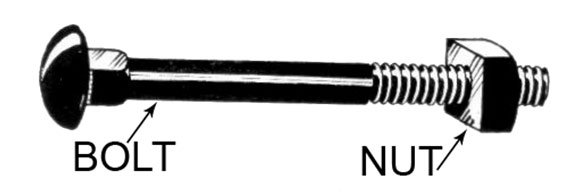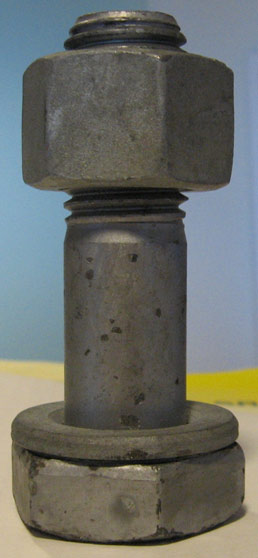A universally accepted distinction between a screw and a bolt does not exist. The Machinery's Handbook describes the distinction as follows:[2]
A bolt is an externally threaded fastener designed for insertion through holes in assembled parts, and is normally intended to be tightened or released by torquing a nut. A screw is an externally threaded fastener capable of being inserted into holes in assembled parts, of mating with a preformed internal thread or forming its own thread, and of being tightened or released by torquing the head. An externally threaded fastener which is prevented from being turned during assembly and which can be tightened or released only by torquing a nut is a bolt. (Example: round head bolts, track bolts, plow bolts.) An externally threaded fastener that has thread form which prohibits assembly with a nut having a straight thread of multiple pitch length is a screw. (Example: wood screws, tapping screws.)
This distinction is consistent with ASME B18.2.1 and some dictionary definitions for screw[3][4] and bolt.[5][6][7]
The issue of what is a screw and what is a bolt is not completely resolved with Machinery's Handbook distinction, however, because of confounding terms, the ambiguous nature of some parts of the distinction and usage variations. Some of these issues are discussed below:
Machine screws
ASME standards specify a variety of “Machine Screws”[8] in diameters ranging up to 3⁄4 of an inch. These fasteners are often used with nuts and they are often driven into tapped holes. They might be considered a screw or a bolt based on the Machinery's Handbook distinction. In practice, they tend to be mostly available in smaller sizes and the smaller sizes are referred to as screws or less ambiguously as machine screws, although some kinds of machine screws can be referred to as stove bolts.
Hex cap screws
ASME standard B18.2.1 -1981 specifies Hex Cap Screws that range in size from 1⁄4 to 3 inches in diameter. These fasteners are very similar to hex bolts. They differ mostly in that they are manufactured to tighter tolerances than the corresponding bolts. The Machinery's Handbook refers parenthetically to these fasteners as “Finished Hex Bolts”.[9] Reasonably, these fasteners might be referred to as bolts but based on the US government document, Distinguishing Bolts from Screws, the US government might classify them as screws because of the tighter tolerance.[10]
Lug bolts & head bolts
These terms refer to fasteners that are designed to be threaded into a tapped hole that is in part of the assembly and so based on the Machinery's Handbook distinction they would be screws. Here common terms are at variance with Machinery's Handbook distinction. This variance, perhaps, originated from common usage ideas that screws are small and bolts are big.[11][12]
Lag bolt
These are clearly screws based on the Machinery's Handbook distinction. The term has been replaced by "Lag Screw" in the Machinery's Handbook[13] and probably only continues in common usage because of common language notion that bolts are big.
Government standards
The US government made an effort to formalize the difference between a bolt and a screw because different tariffs apply to each. The document seems to have no significant effect on common usage and does not eliminate the ambiguous nature of the distinction between screws and bolts for some threaded fasteners.[14]
Historical issue
Old USS and SAE standards defined cap screws as fasteners with shanks that were threaded to the head and bolts as fasteners with shanks that were partially unthreaded.[15] This is now an obsolete distinction.
Controlled vocabulary versus natural language
The distinctions delineated above are enforced in the controlled vocabulary of standards organizations. Nevertheless, there are sometimes differences between the controlled vocabulary and the natural-language usage of the words among machinists, auto mechanics, and other workers. These differences reflect linguistic evolution shaped by the changing of technology over centuries. The words bolt and screw have both existed since before today's modern mix of fastener types existed, and the natural usage of those words has evolved retronymously in response to the technological change. (That is, the use of words as names for objects changes as the objects themselves change.) Nonthreaded fasteners predominated in fastening technology until the advent of practical, inexpensive screw-cutting in the early 19th century. The basic meaning of the word screw has long involved the idea of a helical screw thread, but the Archimedes screw and the screw gimlet (like a corkscrew) preceded the fastener.
The word bolt is also a very old word, and it was used for centuries to refer to metal rods that passed through the substrate to be fastened on the other side, often via nonthreaded means (clinching, forge welding, pinning, wedging, etc). The connection of this sense to the sense of a door bolt or the crossbow bolt is apparent. In the 19th century, bolts fastened via screw threads were often called screw bolts in contradistinction to clench bolts.
In common usage, the distinction is often that screws are smaller than bolts, and that screws are generally tapered and bolts are not. This distinction is not rigorous.
Other distinctions
Bolts have been defined as headed fasteners having external threads that meet an exacting, uniform bolt thread specification (such as M, MJ, UN, UNR, and UNJ) such that they can accept a nontapered nut. Screws are then defined as headed, externally-threaded fasteners that do not meet the above definition of bolts.[citation needed] These definitions of screw and bolt eliminate the ambiguity of the Machinery's handbook distinction. And it is for that reason, perhaps, that some people favor them. However, they are neither compliant with common usage of the two words nor are they compliant with formal specifications.

